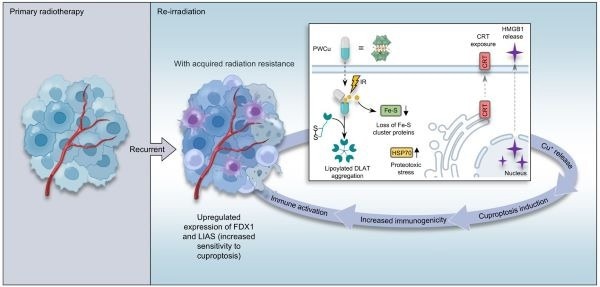Reviewed by Lexie CornerSep 23 2024
Researchers from the Institute of High Energy Physics at the Chinese Academy of Sciences and Peking Union Medical College Hospital have identified cuproptosis as a potential target for radiosensitization in re-irradiation. This study was published in Nature Nanotechnology.
 Re-irradiation sensitization mediated by copper-containing nanocapsules. Image Credit: Prof. Gu's group
Re-irradiation sensitization mediated by copper-containing nanocapsules. Image Credit: Prof. Gu's group
Prof. Zhanjun Gu and Drs. Junfang Yan and Fuquan Zhang were involved in the study.
Re-irradiation poses a significant clinical challenge, as patients undergoing secondary radiotherapy for cancer often face both compromised physical health and increased radiation resistance in tumor cells. This issue is particularly critical for elderly and advanced-stage cancer patients who urgently need effective radiosensitizing drugs.
Using synchrotron radiation facilities, researchers found, for the first time, that cuproptosis-related proteins were highly expressed in tumor tissues under X-ray irradiation. They also identified a novel mechanism of cell death triggered by copper ions, termed cuproptosis, which could serve as a new target for radiosensitization.
Based on this discovery, the team developed PWCu, a copper-containing polyoxometalate, as a targeted radiosensitizer for re-irradiation. These PWCu nanocapsules enter tumor cells and release copper ions during radiation therapy, inducing cuproptosis and overcoming the tumor's acquired radiation resistance. Additionally, they can trigger an abscopal effect, leading to immunogenic cell death and enhancing the immune system's anti-cancer response.
These findings suggest that PWCu nanocapsules provide a dual approach, enhancing the local antitumor effects of radiation therapy and stimulating systemic immune responses against tumors. They show great potential for improving outcomes in recurrent and metastatic cancers.
The team also developed advanced analytical techniques using synchrotron radiation to study the oxidation states, biological distribution, and metabolic transformation of copper ions within tumor tissues. This research is crucial for understanding the structure-function relationships and metabolic processes of copper-based radiosensitizers, supporting pharmacokinetic and preclinical safety assessments.
With substantial academic value and promising clinical applications, this study presents a novel approach to the clinical problem of re-irradiation in cancer patients.
Journal Reference:
Liao, Y., et al. (2024) A cuproptosis nanocapsule for cancer radiotherapy. Nature Nanotechnology. doi.org/10.1038/s41565-024-01784-1